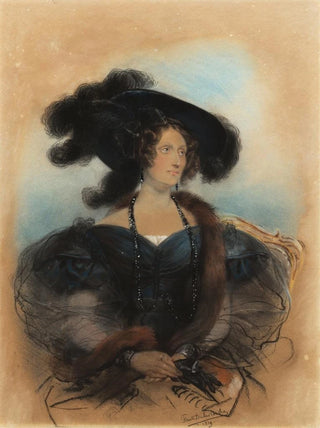Art print | Jane Jarvis - Paul Delaroche


View from behind

Frame (optional)
Jane Jarvis Art print by Paul Delaroche – Captivating Introduction
The canvas "Jane Jarvis" by Paul Delaroche is an iconic work that transcends time and styles. In this painting, the artist manages to capture the very essence of his subject, offering an immersion into a world where emotion and technique meet. Jane Jarvis, the central figure of this composition, is depicted with such intensity that the viewer cannot help but feel the depth of her gaze. This work, both delicate and powerful, invites reflection on the human condition, while revealing Delaroche's virtuosity, a master of 19th-century realism.
Style and uniqueness of the work
Paul Delaroche's style is characterized by striking realism, blending meticulous attention to detail with a subtle use of light. In "Jane Jarvis," he succeeds in creating an intimate atmosphere, where each element of the composition contributes to reinforcing the emotion conveyed by his model's face. The drapes of the clothing, the textures of the skin, and the nuances of color harmonize to bring to life a scene that seems almost tangible. This work stands out for its psychological approach, with Delaroche striving not only to depict a figure but to reveal her soul. The nuances of light caressing Jane Jarvis's face add an almost spiritual dimension to this representation, making the work even more captivating and memorable.
The artist and his influence
Paul Delaroche, born in Paris in 1797, is often regarded as a pioneer of realism in painting. His career was marked by an relentless quest for truth and authenticity, earning him recognition both in France and abroad. Delaroche drew inspiration from past masters while forging his own style, thus influencing an entire generation of artists. His penchant for historical subjects and psychological portraits opened the way to a new way of perceiving painting, where emotion and storytelling take precedence over simple representation. "Jane Jarvis" is a perfect example of this approach, illustrating how the artist manages to transcend the simple portrait to offer a profound reflection on the individual and their context.

Matte finish

View from behind

Frame (optional)
Jane Jarvis Art print by Paul Delaroche – Captivating Introduction
The canvas "Jane Jarvis" by Paul Delaroche is an iconic work that transcends time and styles. In this painting, the artist manages to capture the very essence of his subject, offering an immersion into a world where emotion and technique meet. Jane Jarvis, the central figure of this composition, is depicted with such intensity that the viewer cannot help but feel the depth of her gaze. This work, both delicate and powerful, invites reflection on the human condition, while revealing Delaroche's virtuosity, a master of 19th-century realism.
Style and uniqueness of the work
Paul Delaroche's style is characterized by striking realism, blending meticulous attention to detail with a subtle use of light. In "Jane Jarvis," he succeeds in creating an intimate atmosphere, where each element of the composition contributes to reinforcing the emotion conveyed by his model's face. The drapes of the clothing, the textures of the skin, and the nuances of color harmonize to bring to life a scene that seems almost tangible. This work stands out for its psychological approach, with Delaroche striving not only to depict a figure but to reveal her soul. The nuances of light caressing Jane Jarvis's face add an almost spiritual dimension to this representation, making the work even more captivating and memorable.
The artist and his influence
Paul Delaroche, born in Paris in 1797, is often regarded as a pioneer of realism in painting. His career was marked by an relentless quest for truth and authenticity, earning him recognition both in France and abroad. Delaroche drew inspiration from past masters while forging his own style, thus influencing an entire generation of artists. His penchant for historical subjects and psychological portraits opened the way to a new way of perceiving painting, where emotion and storytelling take precedence over simple representation. "Jane Jarvis" is a perfect example of this approach, illustrating how the artist manages to transcend the simple portrait to offer a profound reflection on the individual and their context.






